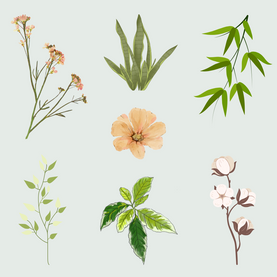What Are Sustainable Fabrics?
Sustainable fabrics are made using processes that cause minimal harm to the environment, animals, and people. Unlike conventional, these processes conserve resources, reduce waste, and prioritize ethical labor practices.
While the most sustainable fabrics are the ones you already own, because reusing clothing avoids the environmental cost of producing new items, there are times when you need to buy new items. Here’s a breakdown of the best sustainable fabrics and why they’re better for the planet.
1. Organic Cotton or Recycled Cotton
Unlike regular cotton, organic cotton is grown without synthetic pesticides or fertilizers. This keeps harmful chemicals out of the soil and water, helping to protect the environment. It also uses less water and provides the same soft, breathable qualities that make cotton a popular option. Recycled cotton is made from cotton waste. It reduces the need for new fabrics and helps keep textile waste out of landfills.
2. Linen
Linen comes from flax plants, which require minimal water and very few pesticides to grow. It’s biodegradable and gets softer with each wash. Compared to cotton, linen lasts longer, making it a practical and sustainable fabric choice.
3. Tencel
Tencel is derived from sustainably sourced wood pulp—often from eucalyptus, beech, or spruce trees. It’s produced through a closed-loop system which means that during production, water and solvents are recycled and reused instead of being discarded. This process reduces waste, conserves resources, and prevents harmful chemicals from polluting the environment. Tencel is biodegradable, and has a soft, and silky texture.
4. Organic Hemp
Organic Hemp is one of the most sustainable fabrics available. It grows quickly, needs little water, and naturally enriches the soil by returning nutrients. It’s also naturally pest-resistant, reducing the need for harmful pesticides. Plus, hemp fibers are incredibly durable—clothes made from hemp last a long time, making them a smart, sustainable choice.
5. Recycled wool
Wool, when sourced responsibly, is a renewable and biodegradable fiber, but it’s also resource-intensive to produce. Recycled wool is made by reprocessing wool scraps or old garments, reducing waste while maintaining the durability and warmth of regular wool.
6. Cupro (Bemberg)
Cupro is a silk-like fabric made from recycled cotton linter—a byproduct of cotton production. Like Tencel, it’s created using a closed-loop process that minimizes waste and conserves resources. It’s breathable, soft, and fully biodegradable.
7. Upcycled and Secondhand Clothing
Upcycled and secondhand clothing are among the most sustainable fashion choices. Upcycling gives new life to old garments by turning them into something fresh and unique, reducing waste and the demand for new resources.
Secondhand shopping extends the lifespan of existing clothes, keeping them out of landfills while saving water, energy, and raw materials that would otherwise go into producing new items. Both options help reduce fashion’s environmental impact while offering affordable and one-of-a-kind wardrobe pieces.
Conclusion
Sustainable fabrics are more than just a trend; they’re a necessity for a healthier planet. By embracing eco-friendly options, we can reduce our environmental footprint, support ethical practices, and pave the way for a more sustainable future in fashion.
Sources
https://goodonyou.eco/most-sustainable-fabrics/ https://goodonyou.eco/material-guide-man-made-cellulosic-fibres/
https://www.bbcearth.com/news/six-fashion-materials-that-could-help-save-the-planet
